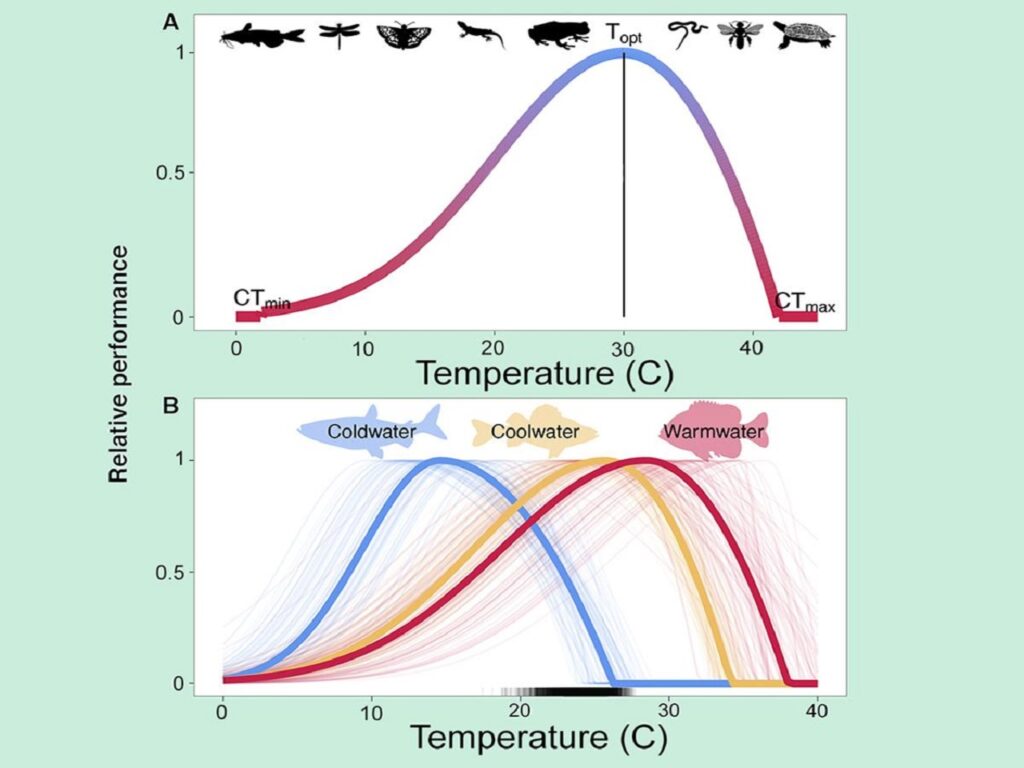Poikilothermic animals make up the majority of species on Earth and are particularly sensitive to temperature changes.
A Penn State-led research team has developed a statistical model that improves estimates of cold-blooded animal habitat suitability and extinction probability as temperatures rise.
Cold-blooded animals include fish, reptiles, amphibians, and insects. Their growth, reproductive success, and survival are all closely related to environmental temperatures.
According to Tyler Wagner, a scientist with the U.S. Geological Survey and a Penn State adjunct professor of fisheries ecology, understanding the future effects of climate change on biodiversity is a global priority.
However, predicting where a species will exist and in what abundance under future temperatures is extremely difficult, he noted, because it requires estimating responses to temperatures that the animals have not yet experienced. Scientists have yet to observe many species.
Researchers developed a statistical method to fuse data collected in the field and laboratory-derived information about species-specific temperature performance and tolerance to help inform landscape-scale predictions under future climates not experienced by animals in their current ranges in a new study to estimate the effects of climate change on cold-blooded animals more precisely.
The “Physiologically Guided Abundance Model,” or PGA Model, is thought to have great potential for informing the development of climate adaptation and management strategies.
Wagner, who is the assistant unit leader of the Pennsylvania Cooperative Fish and Wildlife Research Unit in the College of Agricultural Sciences, said, “The challenge was how to combine these two sources of information and use laboratory-derived information to help inform landscape-scale predictions under future climates not experienced by animals in their current ranges. The model we created accomplishes that.”
The PGA model predicts species’ geographical distributions and abundance in response to a warming world by combining observations of species abundance and environmental conditions with laboratory-derived data on the physiological reaction of cold-blooded animals to temperature. Wagner claims that it is difficult to predict the fate of cold-blooded animals without including species’ physiological preferences in a model.
He said, “When trying to predict, or extrapolate, the effects of climate change on animal distribution and abundance, scientists often only use information that describes the relationships between abundance and distributions and temperature under current conditions. These relationships are then used to extrapolate under future temperature conditions.”
According to Wagner, this approach assumes that species-environment relationships are biologically meaningful under future temperatures. Importantly, fails to account for the close relationship between environmental temperatures and cold-blooded animal physiology.
He said, “Although cold-blooded animals are understudied when it comes to an understanding of how their distributions and abundance will respond to climate change, these animals are relatively well-studied when it comes to laboratory-derived information about how changes in environmental temperatures affect physiology and performance. Most cold-blooded animals share a similar functional response in relative performance with increasing temperatures, which can be generalized across a diversity of taxa.”
The researchers developed their PGA model using data from three fish species that differ in thermal preference and tolerance across more than 1,300 lakes in the Midwest of the United States. They compared the results of the PGA model to those of a traditional model that does not account for species’ physiological responses.
Under the current conditions and for temperatures of 1.8, 3.6, 5.4, and 7.2 degrees, the PGA model predicted species distributions and abundance at each lake. The expected average regional increase in air temperature for the Midwest region for 2071-2100 is 7.2 degrees Fahrenheit.

The PGA model’s results were compared to those of a traditional model that does not account for species’ physiological responses.
A new study discovered that cold-adapted fish would become extinct in 61% of their current habitat as temperatures rise.
The researcher said, “We showed that temperature-driven changes in distribution, local extinction, and abundance of cold-, cool- and warm-adapted species varied substantially when physiological information was incorporated into the model. The PGA model provided more realistic predictions under future climate scenarios compared with traditional approaches and has great potential for more realistically estimating the effects of climate change on cold-blooded species.”
Gretchen Hansen, an assistant professor at the University of Minnesota and a study co-author, suggested that models that do not account for physiological preferences might underestimate the risk that climate change poses.
The research was funded by the U.S. Geological Survey Midwest Climate Adaptation Science Center and the National Science Foundation.
Journal Reference:
Tyler Wagner, Erin M. Schliep, etal. Predicting climate change impacts on poikilotherms using physiologically guided species abundance models. Proceedings of the National Academy of Sciences. DOI: 10.1073/pnas.2214199120
